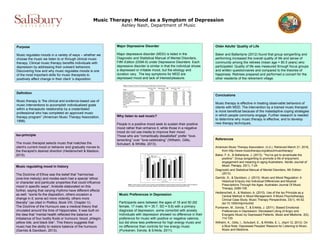
poster
- 1. Music Therapy: Mood as a Symptom of Depression Ashley Nash, Department of Music Purpose Music regulates moods in a variety of ways – whether we choose the music we listen to or through clinical music therapy. Clinical music therapy benefits individuals with depression by addressing their outward behaviors. Discovering how and why music regulates moods is one of the most important skills for music therapists to positively affect change in their client ’s disposition. Definition Music therapy is “the clinical and evidence-based use of music interventions to accomplish individualized goals within a therapeutic relationship by a credentialed professional who has completed an approved music therapy program” (American Music Therapy Association, 1998). Conclusions Music therapy is effective in treating observable behaviors of clients with MDD. The intervention by a trained music therapist is more beneficial because of the maladaptive coping strategies in which people commonly engage. Further research is needed to determine why music therapy is effective, and to develop new therapy techniques. References American Music Therapy Association. (n.d.). Retrieved March 21, 2016, from http://www.musictherapy.org/about/musictherapy/ Baker, F. A., & Ballantyne, J. (2013). “You've got to accentuate the positive”: Group songwriting to promote a life of enjoyment, engagement and meaning in aging Australians. Nordic Journal of Music Therapy, 22(1), 7-24. Diagnostic and Statistical Manual of Mental Disorders, 5th Edition. (2013). Garrido, S., & Davidson, J. (2013). Music and Mood Regulation: A Historical Enquiry into Individual Differences and Musical Prescriptions Through the Ages. Australian Journal Of Music Therapy, 2489-109. Heiderscheit, A., & Madson, A. (2015). Use of the Iso Principle as a Central Method in Mood Management: A Music Psychotherapy Clinical Case Study. Music Therapy Perspectives, 33(1), 45-52. doi:10.1093/mtp/miu042 Punkanen, M., Eerola, T., & Erkkila, J. (2011). Biased Emotional Preferences in Depression: Decreased Liking of Angry and Energetic Music by Depressed Patients. Music and Medicine, 3(2), 114-120. Wilhelm, K., Gillis, I., Schubert, E., & Whittle, E. L. (April 12, 2013). On a Blue Note: Depressed Peoples' Reasons for Listening to Music. Music and Medicine. Older Adults’ Quality of Life Baker and Ballantyne (2012) found that group songwriting and performing increased the overall quality of life and sense of community among the retirees (mean age = 80.5 years) who participated. Quality of life was measured through focus groups and written questionnaires and compared to the theories of happiness. Retirees prepared and performed a concert for the other residents of the retirement village. Why listen to sad music? People in a positive mood seek to sustain their positive mood rather than enhance it, while those in a negative mood do not use media to improve their mood. Those who are “romantically dissatisfied” prefer “love- lamenting” over “love-celebrating” (Wilhelm, Gillis, Schubert, & Whittle, 2013). Music Preferences in Depression Participants were between the ages of 18 and 50 (62 female, 17 male; M = 35.7, SD = 9.8) with a primary diagnosis of depression, some comorbid with anxiety. Individuals with depression showed no difference in their preference for music with positive or negative valence, but did show less preference for high energy music and no difference than controls for low energy music (Punkanen, Eerola, & Erkkila, 2011). Iso-principle The music therapist selects music that matches the client’s current mood or behavior and gradually moves to the therapist’s desired direction (Heiderscheit & Madson, 2015). Music regulating mood in history The Doctrine of Ethos was the belief that “harmonias (one-line melody) and modes each had a special ‘ethos’ or character and particular properties that could influence mood in specific ways”. Aristotle elaborated on this further, saying that varying rhythms have different effects as well: “some fix the disposition, others occasion a change in it; some act more violently, others more liberally” (as cited in Politics, Book VIII, Chapter V). The Doctrine of the Humours was a medical theory that circulated around the time of Hippocrates. It was built on the idea that “mental health reflected the balance or imbalance of four bodily fluids or humours: blood, phlegm, yellow bile, and black bile”. This theory suggests that music has the ability to restore balance of the humours (Garrido & Davidson, 2013). Major Depressive Disorder Major depressive disorder (MDD) is listed in the Diagnostic and Statistical Manual of Mental Disorders, Fifth Edition (DSM-5) under Depressive Disorders. Each depressive disorder is similar in that the individual shows a depressed or irritable mood, but the etiology and duration vary. The key symptoms for MDD are depressed mood and lack of interest/pleasure.